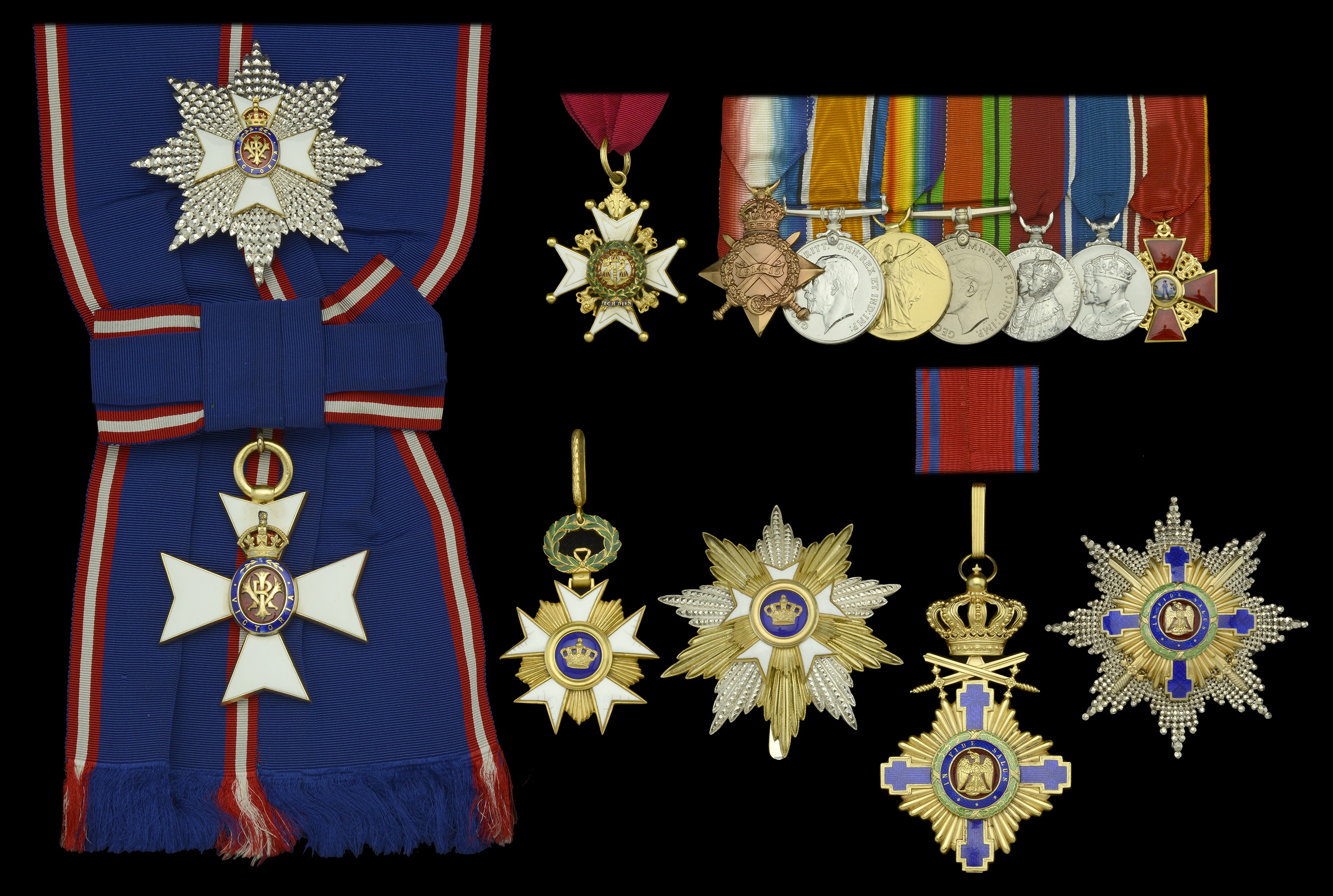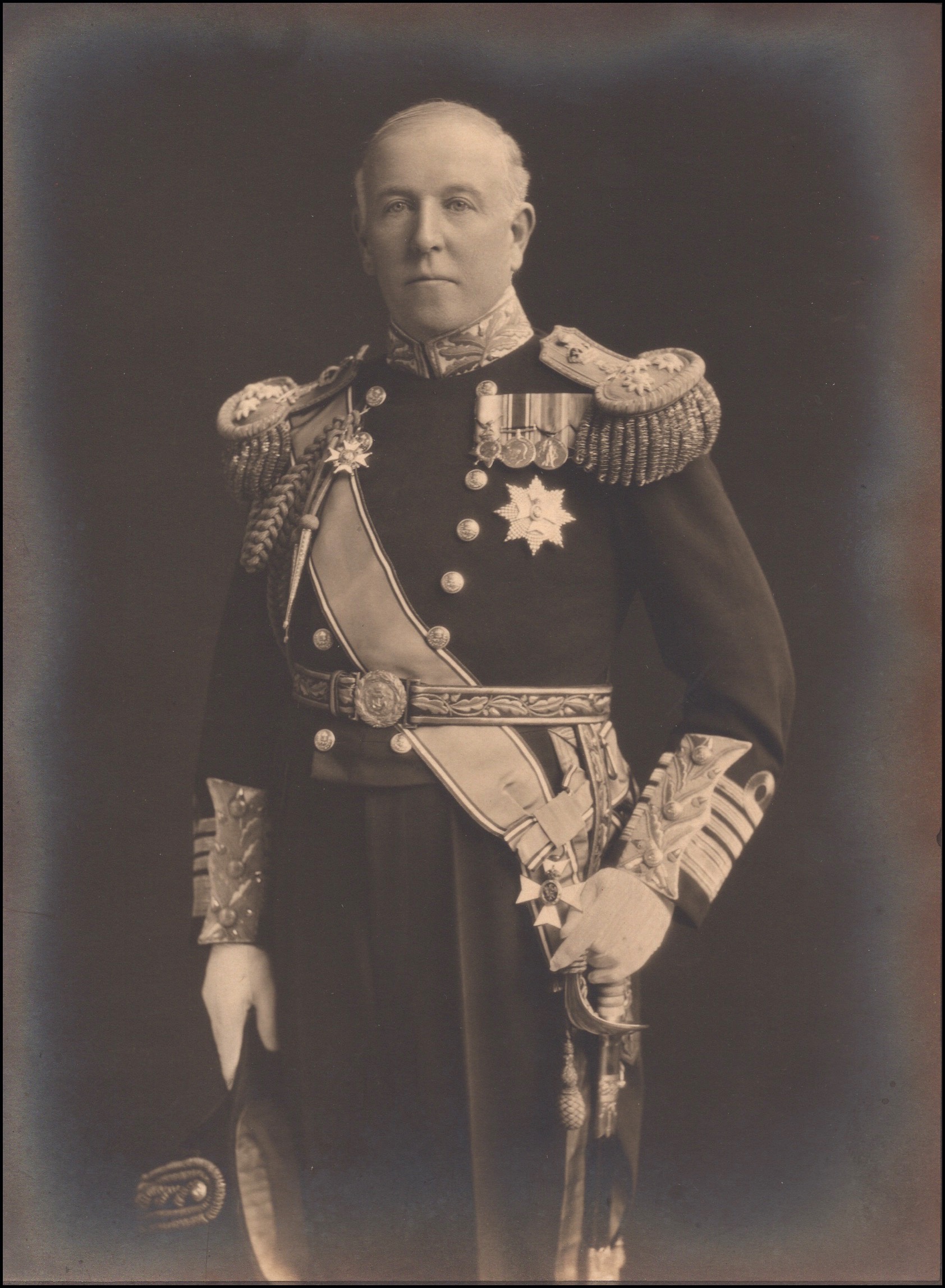The impressive ‘Flag Officer Royal Yachts’ G.C.V.O., Great War C.B. group of thirteen to Admiral Sir Henry Buller, Royal Navy, who commanded H.M.S. Highflyer in her epic engagement with the German cruiser Kaisar Wilhelm der Grosse off Rio de Oro in August 1914, an action extensively portrayed the pages of ‘Deeds That Thrill The Empire’ The Royal Victorian Order, G.C.V.O., Knight Grand Cross set of insignia, comprising sash badge, silver-gilt and enamels and breast star, silver, with gilt and enamel centre, both officially numbered ‘581’ on reverse, in Collingwood, London numbered case of issue; The Most Honourable Order of the Bath, C.B. (Military) Companion’s neck badge, silver-gilt and enamels, in damaged Garrard, London case of issue; 1914-15 Star (Capt. H. T. Buller, M.V.O., R.N.); British War and Victory Medals (Capt. H. T. Buller. R.N.); Defence Medal 1939-45; Jubilee 1935; Coronation 1953; Russia, Empire, Order of St. Anne, Third Class breast badge by Keibel, gold and enamels, two reverse arms chipped, these last seven mounted court-style as worn; Belgium, Order of the Crown, Knight Grand Cross set of insignia, by Wolravens, Brussels, comprising sash badge, silver-gilt and enamels, and breast star, silver with silver-gilt and enamel centre, in case of issue; Roumania, Order of the Star (Military), Second Class set of insignia, by Resch, Bucharest, comprising neck badge, silver-gilt and enamels, and breast star, silver, with silver-gilt and enamel centre, in case of issue, unless otherwise described, good very fine and better (14) £4,000-£5,000 --- Importation Duty This lot is subject to importation duty of 5% on the hammer price unless exported outside the UK --- --- Provenance: Spink, July 2000. G.C.V.O. London Gazette 11 August 1930: For services as Flag Officer Royal Yachts. C.B. London Gazette 1 January 1919: ‘In recognition of services during the War.’ The original recommendation states: ‘Sank Kaiser Wilhelm de Grosse. Extract from letter to Rear-Admiral, Carnarvon: Captain Buller’s action has their Lordship’s complete approval in every respect for the humane and correct manner in which he did his duty.’ Henry Tritton Buller was born in 1873, the son of Admiral Sir Alexander Buller, G.C.B., of Erie Hall, Devon and Belmore House, West Cowes, and entered the Royal Navy as a Cadet in January 1887. Regular seagoing duties aside, his subsequent career appointments also included his services as First Lieutenant of the Royal Yacht Victoria and Albert in 1902-04, for which he was awarded the Russian Order of St. Anne in October 1904 and advanced to Commander, and as Commanding Officer of the Royal Naval College, Dartmouth between January 1908 and June 1911. On the Prince of Wales passing out of the college in 1911, Buller was appointed M.V.O. (London Gazette 12 April 1911, refers) and advanced to Captain. His next appointment was Flag Captain Home Fleets at Portsmouth, 1911-12, whence he was appointed to the command of H.M.S. Highflyer, the training ship for special entry cadets. On the day hostilities broke out in 1914, Buller in Highflyer captured to S.S. Tubantia, carrying German reservists and a gold shipment. Three weeks later, he found the German commerce raider Kaiser Wilhelm Der Grosse, coaling in Spanish territorial waters off the mouth of the Oro River, West Africa. On offering the faster vessel the chance to surrender, Buller received the signal: “Germans never surrender, and you must respect the neutrality of Spain.” But since it was known that the commerce raider had abused Spanish neutrality by using the river mouth as a permanent base for some weeks, Buller gave warning that he would attack in half an hour, allowing time for the colliers to withdraw with such personnel as the German captain felt fit. Deeds That Thrill the Empire takes up the story: ‘As soon as the period of grace had elapsed the Highflyer again inquired if the enemy would surrender, and when the answer came, “We have nothing more to say,” the action opened without further parley. The British cruiser let fly with one of her 6-inch guns at a range of just under 10,000 yards; but the shot fell short. The enemy’s guns were smaller - 4.1-inch - but much more modern, and before our shells began to hit the enemy the German projectiles were falling thickly around and upon the Highflyer. One shell went between a man’s legs and burst just behind him, peppering him with splinters. Another struck the bridge just after the captain had left it to go into the conning-tower, and knocked a searchlight overboard. All this time the Highflyer was steaming in so as to get her guns well within range; and when the 100lb shells began to hit they “kept on target” in a manner that spoke well for the training of our gunners. One shot carried away a 4-inch gun on the after-deck of the enemy. Another burst under the quarter-deck and started a fire; a third - perhaps the decisive shot of the action - struck her amidships on the water-line and tore a great rent in her side. From stem to stern the 6-inch shells tore their destructive way, and it was less than half and hour after the fighting began that the “pride of the Atlantic” began to slacken her fire. The water was pouring into the hole amidships, and she slowly began to heel to port. Three boat loads of men were seen to leave her and make for the shore … The Highflyer immediately signalled that if the enemy wished to abandon ship, they would not be interfered with; and as the guns of the Kaiser Wilhelm had by this time ceased to answer our fire, the Highflyer ceased also, and two boats were sent off with surgeons, sick-berth attendants and medical stores, to do what they could for the enemy’s wounded. The ship herself was battered beyond all hope, and presently heeled over and sank in about fifty feet of water. Although Highflyer had been hit about fifteen times her losses amounted to only one man killed and five slightly wounded. The enemy’s loss is unknown, but it is estimated that at least two hundred were killed or wounded, while nearly four hundred of those who had escaped in the colliers were captured a fortnight later in the Hamburg-America liner Bethania … ’ The same source concludes: ‘It was noteworthy as being the first duel of the naval war and as being the first definite step in the process of “clearing the seas.” It is not often the Admiralty evinces any enthusiasm in the achievements of the Fleet, and the following message despatched to the victorious cruiser is therefore all the more remarkable: “Admiralty to Highflyer – Bravo! You have rendered a service not only to Britain, but to the peaceful commerce of the world. The German officers and crew appear to have carried out their duties with humanity and restraint, and are therefore worthy of all seamanlike consideration.” Buller departed Highflyer in May 1916, when he was appointed Naval Assistant to the Second Sea Lord at the Admiralty, but he returned to sea as Flag Captain in the Barham in April 1918, and as Commanding Officer of the Valiant at the war’s end. A succession of ‘royal appointments’ ensued in the 20s and 30s, commencing with his command of the Malaya during the Duke of Connaught’s visit to India in early 1921. He was appointed C.V.O. (London Gazette 25 March 1921, refers) and advanced to Rear-Admiral. He then served as Officer Commanding H.M.’s Yachts during the period of King George V’s cruise in the Mediterranean, and was appointed K.C.V.O. (London Gazette 22 April 1925, refers). ...









